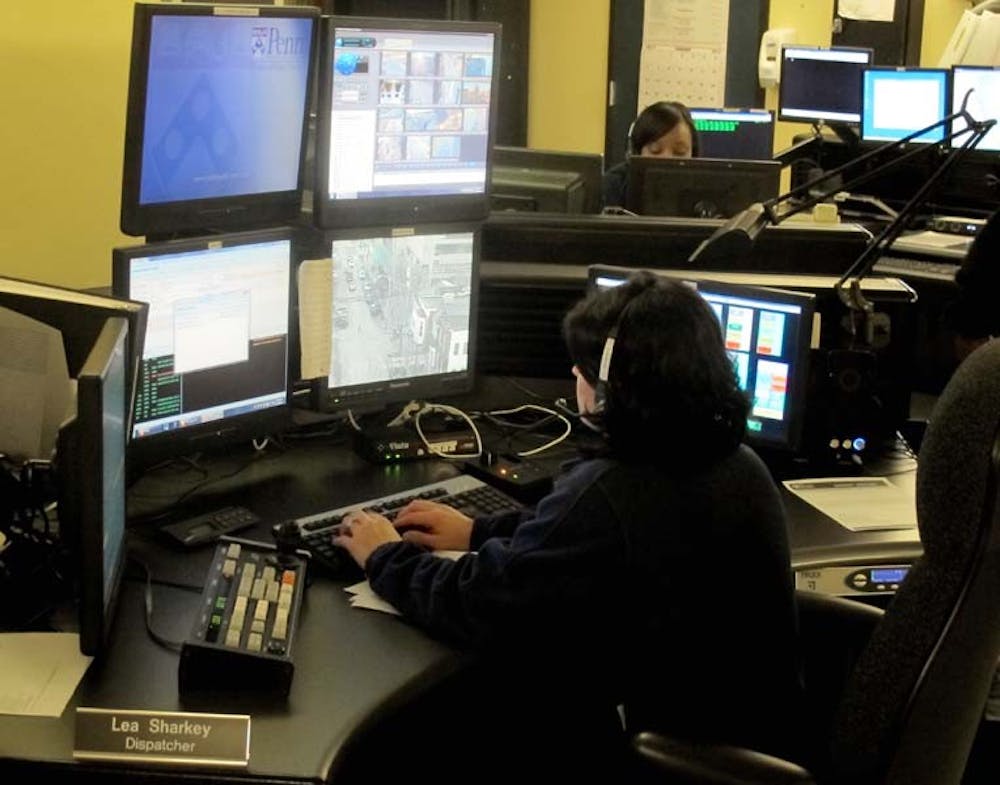
The PennComm center monitors emergency calls and CCTV to prevent crime on campus.
In a room filled with LCD monitors and decorated with wall-sized maps, the emergency dispatchers at the Division of Public Safety work around-the-clock to stop crime on Penn’s campus — even before it happens.
The Penn Communications Operations Center is a conduit that handles 111,000 emergency calls a year and monitors security footage from a total of 123 closed circuit television cameras across campus.
According to Vice President for Public Safety Maureen Rush, PennComm is among a new generation of emergency response centers.
“A lot of [other dispatch centers] have cameras, but not necessarily in their 9-1-1 center,” Rush said.
She also noted that the Philadelphia Police “have come to lean on [PennComm] as partners.”
DPS has the ability to see every 9-1-1 call that comes into the Philadelphia Police Department. For some of the emergency calls that are inside Penn’s patrol zone in the 18th district, DPS will respond to the call instead of city police.
Every month, DPS takes 130 emergency responses off of the city’s hands, according to Director of Technology and Emergency Communications Mitch Yanak.
“A lot of money, time and energy” has been put into improving the neighborhood around Penn, Yanak said, an effort which includes all that goes on at the PennComm Center.
Dispatchers at PennComm also look at 9-1-1 calls that are outside of the 18th District but still close enough to possibly affect Penn, said IT Project Manager Bob Curry. “If there are three city cop cars flying down Walnut Street, we want to know what’s going on,” he said.
The PennComm Center employees come from all types of backgrounds. Some were police officers or Allied Barton employees — one was a hairdresser.
A major part of their job is monitoring the security cameras around campus. Rush referred to the employees of PennComm as a “force multiplier” in DPS’s goal of keeping Penn safe.
The employees are always watching suspicious behaviors of people around campus, Rush said.
“Not all [PennComm employees] have tech backgrounds,” Curry said. This is one of the reasons why he has been trying to streamline the UPennAlert system.
The system, which launched in February 2008, allows PennComm to alert the entire Penn community about emergencies as they happen.
“Some people get infuriated by emergency notifications,” Curry said. Because of this, PennComm will only send notifications to specific groups at certain times of the day. For example, UPennAlerts that occur after business hours are not sent to faculty who do not reside on campus.
This is also done to conserve data. It takes seven minutes to send a notification text and email to all 60,000 individuals on the UPennAlert system. PennComm keeps about 15 days worth of video on its servers at any given time, as well as recordings of all recent emergency calls.
The UPennAlert system is supplemented by emergency sirens across campus, allowing DPS to broadcast a message should a crisis occur.
The only time the emergency siren system has ever been employed was after the earthquake in August 2011.
Nevertheless, DPS tests the siren system on the first Friday of every month. During this test, students hear Westminster Chimes played throughout campus. According to Curry, this allows DPS to test the system without “freaking people out.”
“If you don’t test, you don’t know,” Yanak said.
This article has been updated to reflect that Vice President for Public Safety Maureen Rush stated that the employees are watching suspicious behaviors of people around campus, not suspicious people.
The Daily Pennsylvanian is an independent, student-run newspaper. Please consider making a donation to support the coverage that shapes the University. Your generosity ensures a future of strong journalism at Penn.
DonatePlease note All comments are eligible for publication in The Daily Pennsylvanian.





